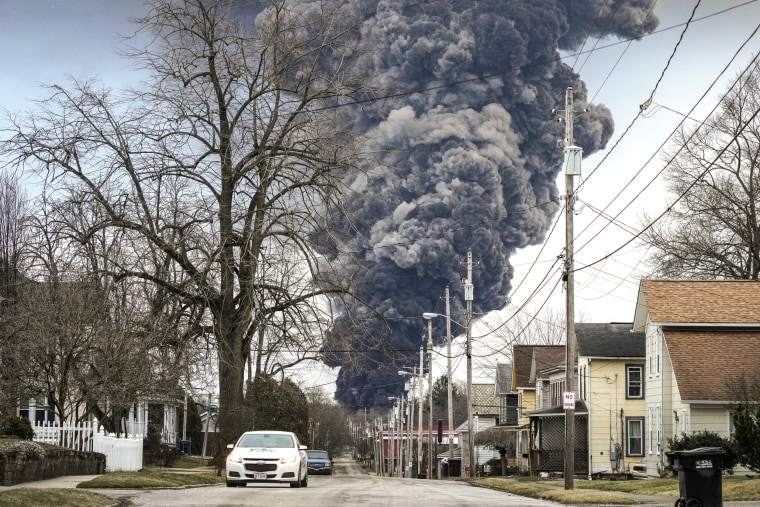When the Environmental Protection Agency last week ordered testing for dioxins after the recent train derailment and fire in East Palestine, Ohio, it acknowledged that residents could be facing a familiar and infamous foe from its past.
Contamination by dioxins — toxic chemicals known to cause cancer, disrupt the immune system and cause reproductive harms — have been at the center of notorious environmental cleanups from Times Beach, Missouri to Love Canal, New York to “Mount Dioxin” in Pensacola, Florida.
Dioxins don’t break down easily. Once in the food chain, the compounds tend to accumulate in people and animals. In key ways, the smoke-belching fire in East Palestine offered the right recipe to create these compounds, experts say.
“I saw that cloud up above East Palestine, and I was immediately concerned about dioxins,” said Dr. Ted Schettler, a retired physician who is the science director for the Science and Environmental Health Network, a nonprofit group. “This is exactly the circumstance where you expect dioxins to form.”
It’s not yet clear if dioxins were created in the derailment or what level of contamination existed in East Palestine before the disaster. Sampling and testing are expensive and can take a long time, experts said. It may take weeks or months before the risk is clear.
During Congressional testimony Thursday, Debra Shore, an EPA regional administrator for midwestern states including Ohio, said testing of materials sent to a contaminated waste facility in Indiana showed “very low levels” of dioxins.
The EPA said that it would require Norfolk Southern to “test directly” for dioxins and to perform a cleanup anywhere levels are found that are unacceptable for human health. The EPA has said it believes the risk that dioxins were produced during the fire is low. Norfolk Southern will also complete a background study to assess the level of dioxins that were already in the environment before the derailment.
In a statement to NBC News on Tuesday, EPA deputy press secretary Khanya Brann said the agency would review every aspect of a sampling plan to ensure it was as “protective as possible” and would modify it if it doesn’t meet the agency’s standards.
In a news release Wednesday, the EPA announced that it had approved a Norfolk Southern plan for soil sampling. The plan requires contractors to inspect at least 277 sites within 2 miles of the derailment to look for visible ash. Sites with visible ash will be sampled; at least 20% of sites without ash will also be sampled. Testing will take at least a week to return results.
In an emailed statement, Norfolk Southern said it had submitted several plans to the EPA for approval to address dioxin testing.
“We pledged to pay for the clean-up activities to date and will continue to do so, while thoroughly and safely cleaning up the site, and we are reimbursing residents for the disruption this has caused in their lives,” the Norfolk Southern statement said. “We are listening to the concerns of the community as restoration work moves forward.”
In recent decades, environmental health regulations dramatically reduced the risk of dioxins for most of the U.S. and helped push dioxins out of the public eye. Now, the threat in East Palestine spotlights the compounds’ toxic history, the risk they could pose to East Palestine residents, and why outside experts have implored the EPA to closely monitor the complicated sampling and testing processes.
Dioxins, if found in even small amounts, could reshape food webs, impact people’s long-term health and alter East Palestine’s long-term prospects.
“It doesn’t take much compared to other toxic chemicals,” said Dr. Arnold Schecter who has written a textbook on dioxins and their health effects.
Dioxins are a byproduct of industrial processes and historically have been associated with paper mills, the vinyl industry and medical waste incinerators.
But they can be created any time there’s a poorly controlled fire involving chlorine, which is why the derailment and cloud of smoke in East Palestine are of such concern.
Five of the derailed cars in East Palestine contained vinyl chloride.
“When you burn vinyl chloride, you can generate quite a lot of dioxins,” said Linda Birnbaum, a toxicologist and a former director of the National Institute of Environmental Health Sciences.
She said it’s possible that residents of East Palestine and its surrounding areas could have inhaled dioxins in the cloud of smoke created in the incident.
Any dioxins produced could settle in soil and water where the smoke traveled. There, they could begin to affect animals, contaminate locally produced foods and pose a risk for anyone working or playing with the soil.

“If you eat it, it goes down to your body and basically gets into your liver and stuff and distributes throughout your body,” Birnbaum said.
Dioxins are stored in fat tissue and can remain for years inside a body, she said.
Health conditions can manifest decades after exposure. In 1976 in Seveso, Italy, a chemical plant exploded, leaking dioxins into nearby towns. About 200 people developed cases of chloracne, a skin condition that looks like acne and forms only in the most serious exposures.
Studies of residents decades later reported increases in cancer risks, deaths from diabetes and effects on fertility.
After dioxins were sprayed throughout the town of Times Beach, the federal government bought out the entire town in 1983 and relocated its residents. After more than a decade of cleanup, the emptied town became a state park.
The EPA in 1996 began the process to relocate the residents in a neighborhood of Pensacola, away from “Mount Dioxin” — a mound of contaminated soil that had been left behind by an abandoned wood treatment plant. The cleanup has taken nearly three decades.
The EPA released its first health assessment of dioxins in 1985, which identified the compounds as likely carcinogens. The agency regulates their levels in drinking water and soil; the Food and Drug Administration monitors for dioxins in the food supply.
“Because of the regulations that have gone in effect, levels have dropped dramatically,” Birnbaum said, estimating that average people’s bodies contain about one-tenth as much dioxin than they did 30 to 40 years ago. “There’s international consensus that dioxins are bad chemicals, and we don’t want to have them.”
Experts said a sampling program for East Palestine would require careful design and very sensitive testing because even tiny amounts of dioxins can be dangerous.
Birnbaum said dioxins in the soil should be tested down to levels in parts per trillion, meaning that they could detect one dioxin amid a trillion other particles. Drinking water samples require even more perceptive testing.
“The concentrations of dioxin which can cause adverse effects in people are extremely low. You’re trying to measure things at very low levels. You need sensitive methodologies,” Birnbaum said.
Experts said a transparent sampling plan should be made available to the public.
“Are they going to sample the air, the soil, the sediment, the water? What are they going to sample and how many locations will they sample?” said Stephen Lester, a toxicologist and the science director of the Center for Health, Environment & Justice. “Sampling results are only as good as the sampling procedures.”
Schettler questioned whether Norfolk Southern should be overseeing sampling efforts, given the legal and economic implications if dioxins are discovered and the scientific precision needed for public confidence.
“Norfolk should pay for the analysis; the public shouldn’t pay for it. But Norfolk Southern shouldn’t do the analysis,” Schettler said. “It really needs to be done by the agency or a disinterested third party.”
